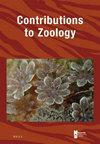Coexistence of two newt species in a transition zone of range overlap
IF 2.2
2区 生物学
Q1 ZOOLOGY
引用次数: 2
Abstract
Theory suggests that spatial segregation of similar, co-occurring species may be driven by alternative innate life history and dispersal strategies, and that it operates through catastrophic events. An inventory of the evolutionary closely related small-bodied newts Lissotriton helveticus and L. vulgaris in the northwest of France demonstrated the species’ spatial partitioning, with L. vulgaris dominating in two pond-rich and historically disturbed coastal areas and L. helveticus prevailing inland where ponds are sparser. Population numbers were followed over several decades (1975–2021) in a pond within the narrow (ca. 2000 m wide) species transition zone. Early in the temporal survey (1986) a massive die-off was observed of two-third of the L. helveticus breeding population from a late frost event. Yet, the contribution of L. helveticus to the newt assemblage was more or less stable around 60%, even though the total population size fluctuated by an order of magnitude. Lissotriton vulgaris and a third species, Ichthyosaura alpestris, made up ca. 30% and 10% of the total till 1993, after which date their relative contributions reversed. These data suggest that a state shift may have occurred among the latter two species and that the assumed two-species dynamics of Lissotriton underlying the study has been an oversimplification. The local decline of L. vulgaris is paralleled by the loss of well-vegetated ponds from the wider agricultural terrain that affects this species more than L. helveticus and I. alpestris.两种蝾螈在范围重叠的过渡区共存
理论表明,相似、共存物种的空间分离可能是由其他先天生活史和扩散策略驱动的,并且它是在灾难性事件中运作的。对法国西北部进化密切相关的小型蝾螈利索里顿helveticus和L.vulgaris的调查表明了该物种的空间划分,L.vulgarias在两个池塘丰富且历史上受到干扰的沿海地区占主导地位,而L.helvetics在池塘较稀疏的内陆地区占主导。在狭窄(约2000米宽)的物种过渡区内的一个池塘中,对种群数量进行了几十年(1975年至2021年)的跟踪。在时间调查的早期(1986年),观察到三分之二的瑞士乳杆菌繁殖种群因晚霜事件而大量死亡。然而,尽管总种群规模波动了一个数量级,瑞士乳杆菌对蝾螈群落的贡献或多或少稳定在60%左右。到1993年,寻常利索特龙和第三个物种阿尔卑斯鱼龙分别占总数的30%和10%,此后它们的相对贡献发生了逆转。这些数据表明,后两个物种之间可能发生了状态转变,并且该研究所假设的利索特里顿的两个物种动力学过于简单化。与L.vulgaris的局部衰退相平行的是,较宽的农业地形失去了植被良好的池塘,这对该物种的影响比L.helveticus和I.alpestris更大。
本文章由计算机程序翻译,如有差异,请以英文原文为准。
求助全文
约1分钟内获得全文
求助全文
来源期刊

Contributions to Zoology
生物-动物学
CiteScore
4.00
自引率
4.50%
发文量
16
审稿时长
>12 weeks
期刊介绍:
Contributions to Zoology solicits high-quality papers in all systematics-related branches of comparative zoology (including paleozoology). Preference will be given to manuscripts dealing with conceptual issues and to integrative papers (e.g., ecology and biodiversity, morphology and phylogeny and character state evolution, phylogeny and historical biogeography, systematics and bioinformatics, bioinformatics and biodiversity, habitat disturbance and biogeography, etc.). Reviews and alpha-taxonomic contributions are considered for publication, but acceptance will depend on their high quality and exceptional nature.
 求助内容:
求助内容: 应助结果提醒方式:
应助结果提醒方式:


